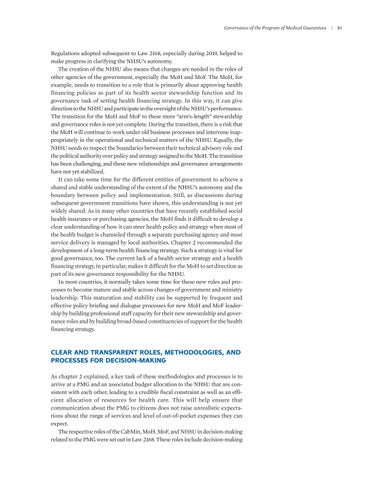Governance of the Program of Medical Guarantees
Regulations adopted subsequent to Law 2168, especially during 2019, helped to make progress in c larifying the NHSU’s autonomy. The creation of the NHSU also means that changes are needed in the roles of other agencies of the government, especially the MoH and MoF. The MoH, for example, needs to transition to a role that is primarily about approving health financing policies as part of its health sector stewardship function and its governance task of setting health financing strategy. In this way, it can give direction to the NHSU and participate in the oversight of the NHSU’s p erformance. The transition for the MoH and MoF to these more “arm’s-length” stewardship and governance roles is not yet complete. During the transition, there is a risk that the MoH will continue to work under old business processes and intervene inappropriately in the operational and technical matters of the NHSU. Equally, the NHSU needs to respect the boundaries between their technical advisory role and the political authority over policy and strategy assigned to the MoH. The transition has been challenging, and these new relationships and governance arrangements have not yet stabilized. It can take some time for the different entities of government to achieve a shared and stable understanding of the extent of the NHSU’s autonomy and the boundary between policy and implementation. Still, as discussions during subsequent government transitions have shown, this understanding is not yet widely shared. As in many other countries that have recently established social health insurance or purchasing agencies, the MoH finds it difficult to develop a clear understanding of how it can steer health policy and strategy when most of the health budget is channeled through a separate purchasing agency and most service delivery is managed by local authorities. Chapter 2 recommended the development of a long-term health financing strategy. Such a strategy is vital for good governance, too. The current lack of a health sector strategy and a health financing strategy, in particular, makes it difficult for the MoH to set direction as part of its new governance responsibility for the NHSU. In most countries, it normally takes some time for these new roles and processes to become mature and stable across changes of government and ministry leadership. This maturation and stability can be supported by frequent and effective policy briefing and dialogue processes for new MoH and MoF leadership by building professional staff capacity for their new stewardship and governance roles and by building broad-based constituencies of support for the health financing strategy.
CLEAR AND TRANSPARENT ROLES, METHODOLOGIES, AND PROCESSES FOR DECISION-MAKING As chapter 2 explained, a key task of these methodologies and processes is to arrive at a PMG and an associated budget allocation to the NHSU that are consistent with each other, leading to a credible fiscal constraint as well as an efficient allocation of resources for health care. This will help ensure that communication about the PMG to citizens does not raise unrealistic expectations about the range of services and level of out-of-pocket expenses they can expect. The respective roles of the CabMin, MoH, MoF, and NHSU in d ecision-making related to the PMG were set out in Law 2168. These roles include decision-making
|
81

